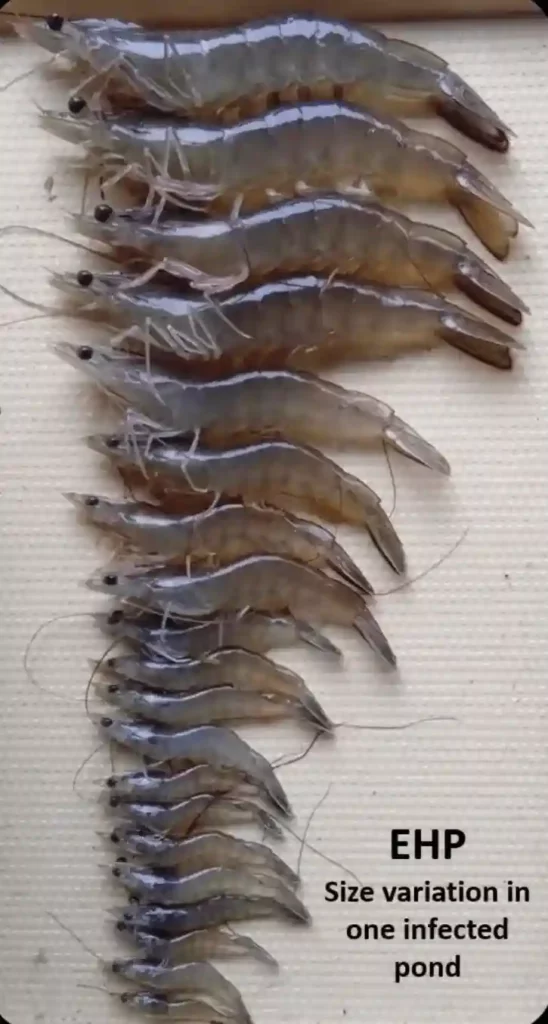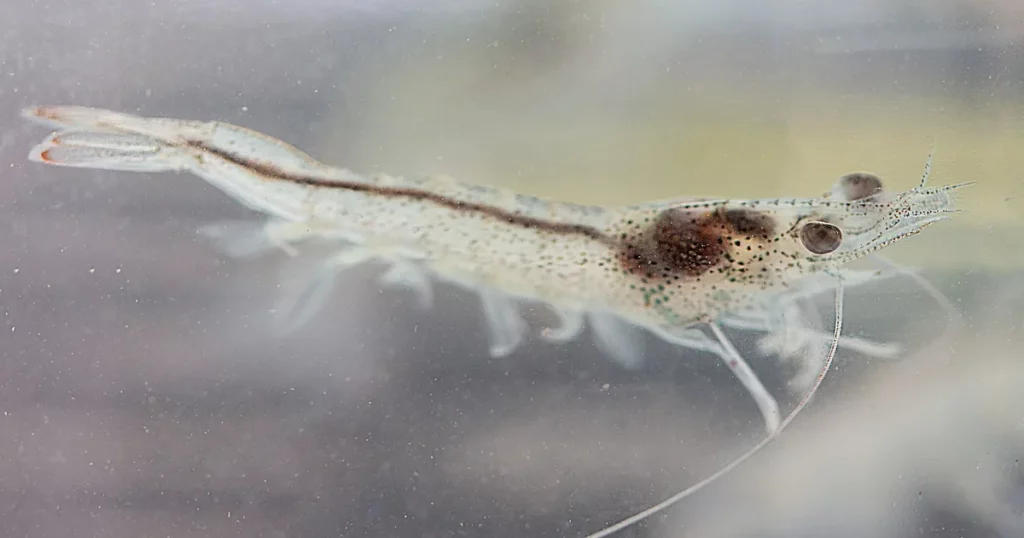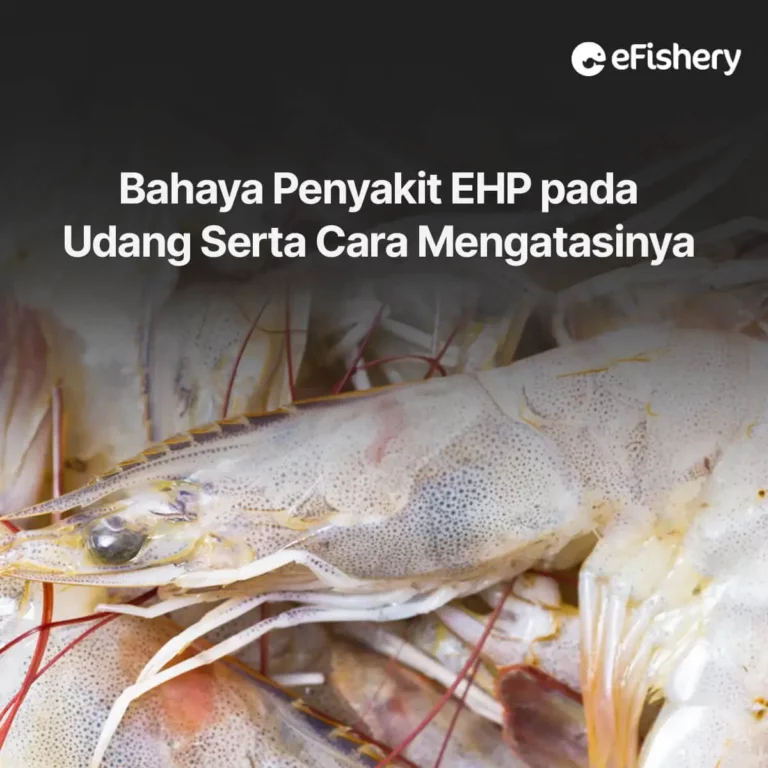Artikel Ini Telah Direview Oleh:

Laksono Radityo
Praktisi Budidaya Udang
EHP diseaseEnterocytozoon hepatopenaei) has often been the enemy of shrimp farmers everywhere. This is because the existence of EHP is considered very detrimental because it can inhibit the growth of shrimp. So, what is EHP in shrimp and how can this pathogen infect shrimp? Find out the answer in this article, come on!
What is EHP?
EHP is a microsporadian fungus or parasite that can cause hepatopancreatic microsporidiosis (HPM) and stunted growth in shrimp. EHP was first discovered in 2004 in the hepatopancreatic tissue of tiger prawns cultured in Thailand. Subsequently, this disease spread and was reported to infect vannamei shrimp in Indonesia in 2015. In India and Indonesia, EHP infection was associated with white feces syndrome (WFS) in cultured shrimp.

The most common cause of EHP in shrimp is parasitic infection Enterocytozoon hepatopenaei, a microsporidian parasite classified in the family Enterocytozoonidae. EHP is known to infect only shrimp hepatopancreatic tubular epithelial cells. Shrimp heavily infected with EHP may display white feces packed with microsporidian spores. Even so, EHP infection will not cause high mortality in shrimp. However, the danger of this parasitic infection is that it greatly inhibits growth and causes large economic losses due to decreased production in shrimp ponds.
Symptoms of EHP Disease
Before the impact of EHP disease on shrimp gets worse, it's a good idea for you to know some of the symptoms so treatment can be done immediately. The following are the symptoms that will appear in shrimp infected with EHP:
- Shrimp growth becomes very slow and WFS occurs (White Stool Syndrome), white fecal discharge from infected shrimp.
- There is a change in shrimp behavior (no appetite).
- Shrimp hepatopancreatic tubular epithelial cells showed basophilic, cytoplasmic inclusions (microsporidian sporocysts).
- Shrimp shell texture becomes soft.
- The pancreatic and midgut of the shrimp become empty.
If there are already shrimp in your pond with indications of EHP disease, you need to be aware of their transmission. Shrimp EHP can be transmitted horizontally through cannibalism between fellow shrimp. In addition, EHP transmission can also occur through EHP spores which are released into the water in shrimp feces. This happens because EHP spores are the infectious stage and the only stage that can survive outside the host.
How to Prevent and Control EHP

EHP is a disease that is quite dangerous because shrimp infected with this virus will experience a decrease in appetite and cannibalism. However, you don't need to worry, here are ways you can do to prevent and control EHP:
- Cultivate shrimp at lower salinity (below 15 ppt) to minimize the severity of EHP infection because at salinities below 15 ppt, Vibrio and the parasite Enterocytozoon hepatopenaei are more difficult to grow.
- Implement good biosecurity.
- Choose SPF fry (Specific Pathogen Free).
- Managing pond water properly because good water quality can reduce stress on shrimp.
- Maintain water quality within the optimum range by:
- Adding probiotics to degrade organic waste and improve water quality.
- Do siphon regularly so that the pond bottom is always in optimal condition.
- Check the quality of the water regularly so that if the quality is not good, prompt and appropriate action can be taken.
- Adding vitamins and immunostimulants to boost the shrimp's immune system to prevent vibriosis. For this, you can use the product Aqua C Fish Plus (2-3 grams/kg of feed) and Coforta A (3 grams/kg of feed) every day treatments (1 hour feed).
- Doing good feed management to prevent overfeeding and decreasing water quality.
- Applying probiotics to improve water quality and prevent disease.
Apart from the precautions above, there are several ways you can do to deal with EHP in shrimp. Here are the ways:
- If the number of deaths due to EHP is not high, you can strictly monitor the shrimp using anco.
- If the shrimp mortality rate is high, you should harvest the shrimp prematurely to avoid further shrimp mortality.
Prevent EHP in Shrimp Through a Free Consultation with an eFishery Aquaculture Expert
Need Help Regarding Shrimp Cultivation Business?
Fill in your personal data in the following form. Our team will immediately contact you via the number cellphone attached. Make sure the data entered is correct.
Even though it is rarely a lethal threat, EHP will be very detrimental to you because it can slow down the growth of the shrimp. Therefore, so that your shrimp farming business avoids losses due to EHP, you can try the above prevention methods and consult with a shrimp farming expert first. eFishery.
eFishery provide consulting services for free through features Cultivation Consultation in app eFarm. Apart from being able to consult directly with shrimp farming experts in the application eFarm, You can also use other features to find more information and buy products that support shrimp farming.
Fill out the form below to access the feature Cultivation Consultation!

Laksono Radityo - Praktisi Budidaya Udang
Berpengalaman sebagai asisten riset perikanan dan teknisi tambak udang. Saat ini aktif sebagai Technical Support Online di eFishery
- https://enaca.org/?id=723
- https://thefishsite.com/articles/how-salinity-impacts-ehp-in-whiteleg-shrimp
- https://thefishsite.com/disease-guide/enterocytozoon-hepatopenaei-ehpp
- https://www.ncbi.nlm.nih.gov/pmc/articles/PMC5216530/
